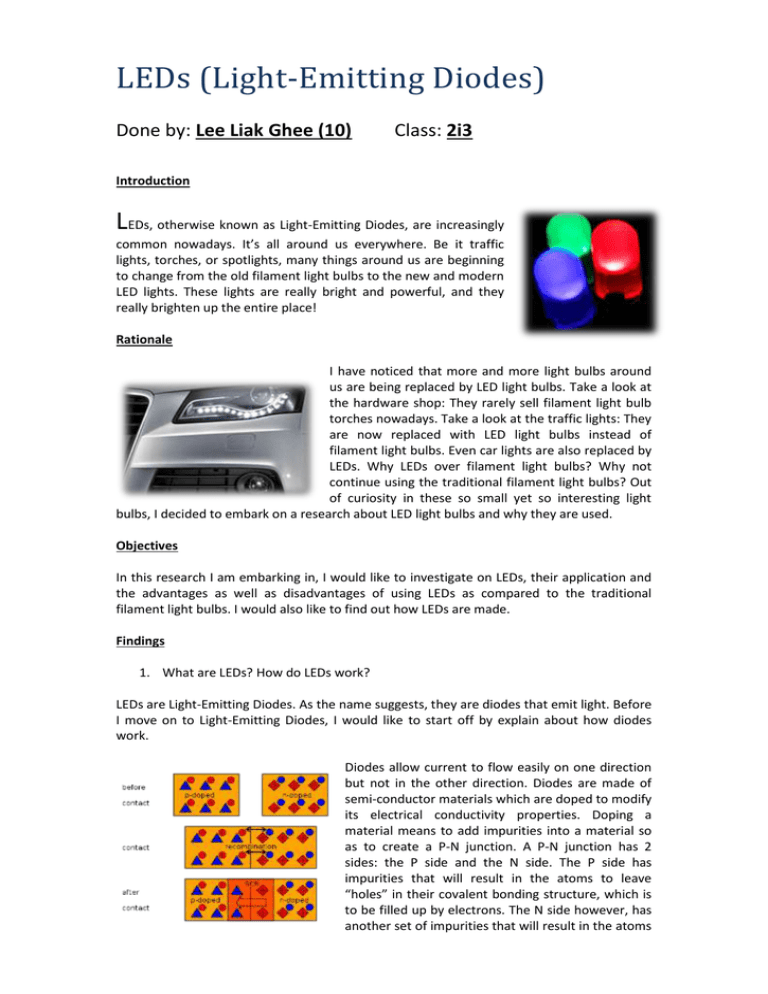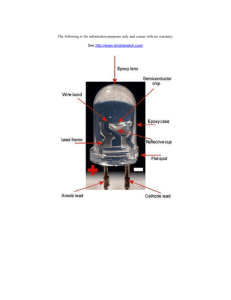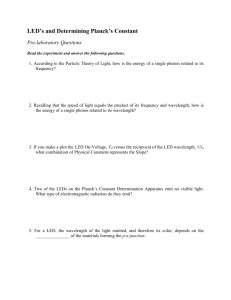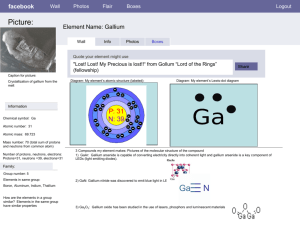Science ACE 2i310
advertisement

LEDs (Light-Emitting Diodes) Done by: Lee Liak Ghee (10) Class: 2i3 Introduction LEDs, otherwise known as Light-Emitting Diodes, are increasingly common nowadays. It’s all around us everywhere. Be it traffic lights, torches, or spotlights, many things around us are beginning to change from the old filament light bulbs to the new and modern LED lights. These lights are really bright and powerful, and they really brighten up the entire place! Rationale I have noticed that more and more light bulbs around us are being replaced by LED light bulbs. Take a look at the hardware shop: They rarely sell filament light bulb torches nowadays. Take a look at the traffic lights: They are now replaced with LED light bulbs instead of filament light bulbs. Even car lights are also replaced by LEDs. Why LEDs over filament light bulbs? Why not continue using the traditional filament light bulbs? Out of curiosity in these so small yet so interesting light bulbs, I decided to embark on a research about LED light bulbs and why they are used. Objectives In this research I am embarking in, I would like to investigate on LEDs, their application and the advantages as well as disadvantages of using LEDs as compared to the traditional filament light bulbs. I would also like to find out how LEDs are made. Findings 1. What are LEDs? How do LEDs work? LEDs are Light-Emitting Diodes. As the name suggests, they are diodes that emit light. Before I move on to Light-Emitting Diodes, I would like to start off by explain about how diodes work. Diodes allow current to flow easily on one direction but not in the other direction. Diodes are made of semi-conductor materials which are doped to modify its electrical conductivity properties. Doping a material means to add impurities into a material so as to create a P-N junction. A P-N junction has 2 sides: the P side and the N side. The P side has impurities that will result in the atoms to leave “holes” in their covalent bonding structure, which is to be filled up by electrons. The N side however, has another set of impurities that will result in the atoms to have spare electrons in their covalent bonding structure. These electrons are the ones which will allow current to flow easily in one direction (forward-bias), but not in the other (reverse-bias). However, this is not what an LED light bulb is mainly used for. LED lights are used for their function as a light, rather than their function as a diode. These light bulbs, like normal diodes, require a semiconductor. In order for an LED light bulb to actually emit light, that semiconductor needs to be made using special materials. The spare electron from the N side has a lot of energy, and when the current causes the electron to flow and fall into the holes on the P side, the excess energy is then converted into a photon, which is the light we see from LED light bulbs. The wavelength of the LED light emitted varies depending on the materials used to make the semiconductor for the LED light bulb. The information is compiled into the table below: Colour Wavelength (nm) Colour Name 940 880 Infrared Infrared 850 Infrared 660 Ultra Red 635 633 620 High Eff. Red Super Red Super Orange Super Orange Orange Super Yellow Super Pure Yellow Yellow "Incandescent" White Pale White Cool White Super Lime Yellow Super Lime Green High Efficiency Green Super Pure Green Pure Green Aqua Green Blue Green Super Blue Ultra Blue 612 605 595 592 585 4500K 6500K 8000K 574 570 565 560 555 525 505 470 430 LED Semiconductor Material Gallium Aluminum Arsenide / Gallium Arsenide Gallium Aluminum Arsenide / Gallium Arsenide Gallium Aluminum Arsenide / Gallium Aluminum Arsenide Gallium Aluminum Arsenide / Gallium Aluminum Arsenide Gallium Arsenic Phosphide / Gallium Phosphide Indium Gallium Aluminum Phosphide Indium Gallium Aluminum Phosphide Indium Gallium Aluminum Phosphide Gallium Arsenic Phosphide / Gallium Phosphide Indium Gallium Aluminum Phosphide Indium Gallium Aluminum Phosphide Gallium Arsenic Phosphide / Gallium Phosphide Silicon Carbide / Gallium Nitride Silicon Carbide / Gallium Nitride Silicon Carbide / Gallium Nitride Indium Gallium Aluminum Phosphide Indium Gallium Aluminum Phosphide Gallium Phosphide / Gallium Phosphide Indium Gallium Aluminum Phosphide Gallium Phosphide / Gallium Phosphide Silicon Carbide / Gallium Nitride Silicon Carbide / Gallium Nitride Silicon Carbide / Gallium Nitride Silicon Carbide / Gallium Nitride It can be seen from this table of semiconductor materials and colours that LEDs require gallium, aluminum, arsenic, phosphorus, indium, silicon, nitrogen and carbon. The types of materials used depend on the frequency of the LED light waves needed. LEDs come in many shapes and sizes, but the most common type of LED light bulbs are the 5mm cylindrical shaped ones (5th from the left). Usually, the colour of the LED light bulb casing matches the colour of the light itself. 2. What are the advantages and disadvantages of LED technology? Advantages Efficient: LEDs emit more light per watt than traditional filament light bulbs. Shape and size do not affect its efficiency. Colour: LEDs are able to emit a light of an intended colour without the need of using a colour filter, unlike filament light bulbs. This helps to increase the efficiency of the light bulb. Size: LEDs can be very small (<2mm). Filament light bulbs are unable to be that small. They can then be used on circuit boards for other purposes. Cool: LEDs radiate extremely little heat when lighted up, while other lights emit a lot of heat and infrareds which can damage sensitive objects. Dimming: Pulse-width modulation can be used to adjust the brightness of the LED light bulb; The filament in filament lights will remain glowing for a while after the light switches off. Lifespan: It has estimated that LEDs have a lifespan of 35,000 to 50,000 hours; Fluorescent tubes 10,000 to 15,000 hours; Filament bulbs 1,000 to 2,000 hours. Disadvantages Cost: At the moment, LED technology is more expensive than other more conventional lighting technologies in terms of cost. Voltage: LED lights need to be supplied with a voltage above the threshold as well as a current below the rating. This means that a series of resistors are needed. Electrical Polarity: LEDs, being diodes, will only light up when the electrical current is of the correct polarity. Light pollution: LEDs cause more light pollution than other conventional light technologies such as sodium vapour lamps. Blue hazard: Blue LEDs and cool-white LEDs are capable of exceeding the safe limits of the “blue light hazard”, and it can harm our eyes. 3. What are the uses of LED lights? Low energy consumption, long lifespan as well small size has allowed LEDs to be used in many indicators and displays on much equipment we see in our daily lives. Designation signs on buses, traffic lights, watch displays, car lights, and illumination: It’s all around us. Their applications definitely are not limited to what has been listed above. The future holds a lot for LED lights. Due to LEDs being technologically superior over other types of light like fluorescent lights or filament light bulbs, its uses could potentially reach far beyond what it is being used for now. Sooner or later LEDs would be used in home lightings and street lights as well because it is extremely energy efficient and it will help to reduce the energy usage by a lot. The great potential behind LED lights has yet to be fully utilized, and it will surely replace a large portion of the lights we use now in time to come. Conclusion LEDs are getting more and more common nowadays, and there is no doubt that the advantages outweigh its disadvantages. It’s low energy consumption, together with the long lifespan it has as well as its ability to emit different coloured lights of our choice makes people choose LEDs over the traditional filament light bulbs, where its energy consumption is high, and it also burns out a lot more easily. Although LEDs are still more expensive than filament lights or fluorescent lights, I believe that future research and development into this LED technology will enable us to reduce the disadvantages that current LED technology has, and help us to maximize the potential of LED lights to its fullest. References http://en.wikipedia.org/wiki/Light-emitting_diode http://en.wikipedia.org/wiki/Diode http://www.madehow.com/Volume-1/Light-Emitting-Diode-LED.html http://www.oksolar.com/led/led_color_chart.htm http://en.wikipedia.org/wiki/P-n_junction http://ezinearticles.com/?What-The-Future-Holds-for-LED-Lighting&id=789401 http://spie.org/x42365.xml?ArticleID=x42365 http://ecoledlight.blogspot.com/





